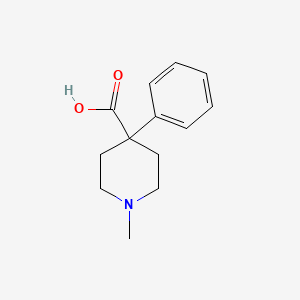|
Name: Meperidine intermediate-A
Type: Opioid
AKA: Meperidine precursor

|
|
II. Natural Derivative
Synthetic substance, no natural derivative
 |
|
III. Chemical Profile (IUPAC name)

|
|
IV. History
Meperidine, also known as pethidine, was first synthesized in 1939 by the German chemist Otto Eisleb. Its intermediate compounds, including intermediate-a, were studied for their role in the synthesis and improvement of meperidine's properties. Meperidine became an important opioid analgesic, used extensively for pain relief during and after surgery. Its use has declined due to the availability of safer alternatives.

|
|
V. Legal Information
Meperidine intermediates are regulated due to their role in the synthesis of controlled substances. In the US, meperidine and its precursors are classified under Schedule II. Globally, there are strict regulations to control the production of opioids and prevent misuse by regulating precursor chemicals.
US Federal Schedule - II
Schedule II drugs, substances, or chemicals are defined as drugs with a high potential for abuse, with use potentially leading to severe psychological or physical dependence. These drugs are also considered dangerous. Some examples of Schedule II drugs are: combination products with less than 15 milligrams of hydrocodone per dosage unit (Vicodin), cocaine, methamphetamine, methadone, hydromorphone (Dilaudid), meperidine (Demerol), oxycodone (OxyContin), fentanyl, Dexedrine, Adderall, and Ritalin.
Key US Federal Policies:
Controlled Substances Act. Public Law: Public Law 91-513 (text can be found on GovInfo) (https://www.dea.gov/drug-information/csa). Date enacted: October 27, 1970.
|
|
VI. Physical Effects
Meperidine intermediate-A is a precursor in the synthesis of meperidine. It is not used directly as a drug but can impact drug production. Its physical effects are not well-documented. Safe handling involves avoiding exposure. Research focuses on its role in pharmaceutical synthesis rather than direct health effects.  |
|
VII. Psychological Effects
Meperidine intermediate, an opioid precursor, affects opioid receptors to provide analgesia and mood alteration. Psychological impacts include euphoria and potential cognitive issues. Immediate effects last several hours, with long-term use carrying risks of dependence and mental health issues. Research focuses on its role in opioid synthesis and overall impact on mental health.
 |
|
VIII. Culture
Meperidine intermediate (a precursor in meperidine synthesis) reflects the development of synthetic opioids. Its cultural significance is tied to the history of opioid pharmacotherapy and the ongoing efforts to manage pain while addressing risks of misuse and dependency. The substance underscores the challenges of opioid development and the quest for effective pain management solutions. Its role in the cultural narrative is one of scientific and medical advancement in opioid treatments.
 |
